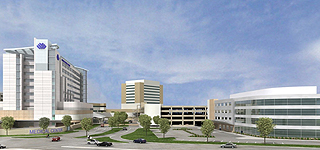
DJC.COM
April 19, 2007
Smarter structural design begins with the right analysis
PCS Structural Solutions

Phair
|
Modern health care facilities often require innovative structural designs to support complex systems and program requirements. Owners are also concerned with project costs.
Performance-based design, a rigorous nonlinear seismic design approach, gives better predictions about a building’s performance. Structural engineers can use this information to enhance the seismic performance of a building while in many cases reduce construction costs.
Previously there was no need for health care owners and architects to consult structural engineers on which analysis technique to use. Today, analysis techniques can affect issues such as a geotechnical engineer’s scope, the permit schedule, complexity of architectural plan irregularities, and even the owner’s insurance policy. The correct analysis technique can also produce significant cost savings to the project.
Comparing procedures

Image courtesy of PCS Structural Solutions A seismic analysis of Renown Regional Medical Center’s $300 million patient tower in Reno, Nev., deterred the owner from over-reinforcing parts of the building. The analysis will save $250,000 in construction costs. |
Linear analysis procedures are most commonly used for building seismic analysis. These distribute seismic forces throughout a building based on linear approximations of element stiffness. The International Building Code allows two types of linear analysis procedures: equivalent lateral force and modal response spectrum.
Equivalent lateral force analysis procedure is by far the simplest method to use, and is still used in most “regular” buildings and medical facilities.
Seismic forces are established through code prescriptive formulas. Compared with a more rigorous analysis, this method can actually give reasonable results in short stiff structures with simple plan configurations. But modern medical facilities are typically more complex structures, and this procedure can be overly conservative.
Modal response spectrum analysis procedures are alternative seismic design methods. This procedure will typically produce more accurate force distribution than the equivalent lateral force procedure.
For example, PCS Structural Solutions performed a 3-D dynamic modal analysis resulting in the elimination of 175 tons of rebar and an entire shear wall from the 340,000-square-foot St. Anthony Hospital project in Gig Harbor.
The modal analysis revealed that force distributions and building deflections to a corner shear wall were different from what was anticipated in an initial equivalent lateral force procedure. The load distribution could be more efficiently accounted for elsewhere.
Modal analysis should be the minimum standard for most medical facility designs. It can significantly reduce construction costs with slightly more analysis time by the structural engineer.
Nonlinear design
Nonlinear or performance-based design procedures are far more technical and rigorous than linear procedures, and are typically only used on buildings over 240 feet tall.
PCS has been using nonlinear procedures on facilities such as medical towers over six stories, emergency wings/trauma centers, and on any facility where owners want a more precise prediction of the building’s performance in multiple seismic events.
Each structural element is modeled based on test results. The structure is subjected to a suite of seven or more earthquake motions at each performance level, providing a better prediction of the building performance and damage at various earthquake levels.
Nonlinear analysis is also more likely to expose undesirable structural mechanisms so they may be eliminated. The complexity of this method demands extensive up-front geotechnical information and usually requires an outside peer review for permit acceptance — time that needs to be accounted for in the schedule.
A nonlinear time history analysis was performed on a 10-story, $300 million Renown Regional Medical Center project in Reno, Nev.
The owner realized over $250,000 in direct cost savings as a result of this analysis, plus a more precise understanding of the structure’s seismic behavior. This procedure allowed “smart” structural detailing and increased seismic performance by putting the money where it was really needed, and not overly reinforcing areas that did not warrant it.
Savings aren’t assured
The nonlinear analysis gives a better prediction of performance but does not always save money up front.
For example, PCS is currently performing a nonlinear time history analysis on a new boiler plant. Extensive open wall space for cladding and varying roof planes (to avoid looking like a boiler plant) resulted in an irregular structure.
The analysis identified areas susceptible to excessive damage during load redistributions. Additional seismic reinforcing of these areas was not significant to the overall budget, but did add to the construction costs. More accurate and predictable seismic performance can cost slightly more up front but may pay large dividends with a well-performing seismic system.
Insurance companies increasingly affect the type of analysis utilized by structural engineers.
Many hospital campus insurance providers now mandate performance-based design methods and specific structural performance. They hope to more accurately verify that anticipated performance levels intended by the code are met, and in some instances mandate higher performance levels to reduce nonstructural damage.
Performance-based design can allow the owner to “shift” the target performance characteristics of the structure beyond the code minimums with the goal of being fully operational more quickly after certain seismic events.
PCS is currently performing a nonlinear time history analysis on the new 320,000-square-foot emergency wing expansion at Tacoma General Hospital, with special performance requirements mandated by the insurance carrier.
Modern medical facilities require expertise in multiple structural analysis procedures and systems to properly address the volatile performance criteria in the industry. Creative structural engineers can offer up-front discussions and analysis solutions to save owners time and money while also creating a better-performing structure.
Brian Phair is a principal with PCS Structural Solutions and works on many of the firm’s educational, correctional and health care facilities.
Other Stories:
- Wal-Mart can teach hospitals about improving patient care
- Shifting health care needs bring technology to the fore
- Technological transformation is shaking up health care
- Keeping an airborne threat at bay
- New technologies cut heating, cooling costs
- Hospitals slowly warming to green design
- Change is coming. Are designers ready?
Copyright ©2009 Seattle Daily Journal and DJC.COM.
Comments? Questions? Contact us.